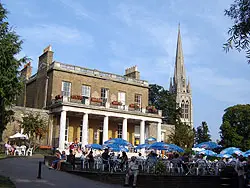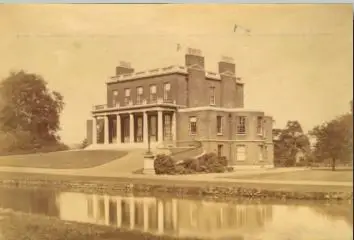
Griselda was the 2nd great grand niece of Jonathan Hoare’s sister’s (grizell) husband’s (William Allen) 2nd wife (Charlotte Hanbury)
source: wikipedia
Clissold House (formerly Paradise House) was built, in the latter half of the 18th century, for Jonathan Hoare, a City merchant, Quaker,philanphropist and anti-slavery campaigner. (His brother, Samuel, half-brother of Sir Joseph Hoare Bt, was one of the founders of the Society for Effecting the Abolition of the Slave Trade.)
The park was created to be his idyll, and the stretch of water which wends its way around the house was once part of the New River, a canal that supplied London with clean water from Hertfordshire.
After 1811, the estate passed, via the Crawshaw family to Augustus Clissold; but, when he died in 1882, developers closed in, and activists John Runtz and Joseph Beck (members of the Metropolitan Board of Works) who convinced the authorities to open it as a public space in 1889. A fountain was erected in 1890 commemorating them; later, the park’s two wildlife ponds were named after them too. As ‘Beckmere’ and ‘Runtzmere’

source: Hackney Council website (page no longer available)
In around 1790, Jonathan Hoare (Samuel’s son) leased land next to St Mary’s old church and began to lay out an estate that he called Stoke Newington Park. By 1793 he had built the mansion, then known as Paradise House.
It is thought that clay for some of the bricks used to build the house was dug from two pits which are now the Clissold Park lakes. The surrounding areas remained as agricultural fields and meadows. The house is unusual in its design, with two storeys on the west side but three storeys on the east. The ground on the west was built up into a carriageway so that the house looks like it is perched on top of a small knoll.
It is thought that the house was designed from the outside to appear as a feature in the landscape, which was very fashionable at the time. The design of the house has been attributed to Jonathan’s nephew, the architect Joseph Woods (1776-1864), but as he was only 17 when the house was built this seems unlikely. No records of the construction of the house or park have been located and so the true identity of the architect remains a mystery.
The estate was laid out with open parkland in the south and woodland in the north. Kitchen gardens were set out to the north east of the house and the eastern area of the estate remained fields.
Jonathan Hoare ran into financial problems and had to mortgage Paradise House to pay debts just five years after it was built. A condition of the mortgage was that he had to pay double if the debt was not repaid in time. Jonathan failed to pay and the bank foreclosed. A popular rumour is that Jonathan was reduced to selling milk door to door from the estate’s farm during this time. Jonathan lost the house and estate and moved to Stoke Newington Church Street where he stayed for the rest of his life.